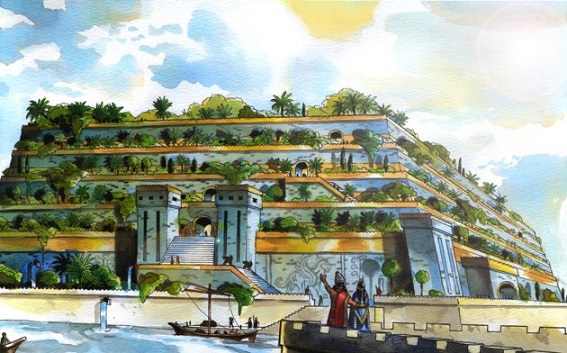10 Interesting Facts About The Ancient Babylonian Empire
Traditionally they were said to have been built in the ancient city of Babylon , near present-day Hillah , Babil province, in Iraq. There are no extant Babylonian texts which mention the gardens, and no definitive archaeological evidence has been found in Babylon. According to one legend, Nebuchadnezzar II built the Hanging Gardens for his Median wife, Queen Amytis , because she missed the green hills and valleys of her homeland.
He also built a grand palace that came to be known as "The Marvel of the Mankind". Because no physical evidence for the Hanging Gardens has be found at Babylon it has been suggested that they were purely mythical, and the descriptions found in ancient Greek and Roman writers including Strabo , Diodorus Siculus and Quintus Curtius Rufus represent a romantic ideal of an eastern garden. Stephanie Dalley suggests that the original garden may have been a well-documented one that the Assyrian king Sennacherib — BC built in his capital city of Nineveh on the River Tigris , near the modern city of Mosul.
There are five principal writers whose descriptions of Babylon are extant in some form today. These writers concern themselves with the size of the Hanging Gardens, their overall design and means of irrigation , and why they were built. Josephus c. For his description of the gardens, Diodorus Siculus active c.
Diodorus ascribes the construction to a Syrian king. The next account is from Quintus Curtius Rufus active 1st century AD , who probably drew on the same sources as Diodorus. Strabo c.
About lilianausvat
Philo of Byzantium 4th—5th century AD [13] is the last of the classical sources. The description of the gardens in his A Handbook to the Seven Wonders of the World is thought to be independent of earlier Greek sources.
The method of raising water by screw matches that described by Strabo. There is some controversy as to whether the Hanging Gardens were an actual construction or a poetic creation, owing to the lack of documentation in contemporaneous Babylonian sources. There is also no mention of Nebuchadnezzar's wife Amyitis or any other wives , although a political marriage to a Median or Persian would not have been unusual.
Ancient texts
Herodotus , who describes Babylon in his Histories , does not mention the Hanging Gardens. To date, no archaeological evidence has been found at Babylon for the Hanging Gardens. Stephanie Dalley posits that during the intervening centuries the two sites became confused, and the extensive gardens at Sennacherib's palace were attributed to Nebuchadnezzar II's Babylon. Dalley bases her arguments on recent developments in the decipherment of contemporary Akkadian inscriptions.
Her main points are: [22].
- 14 Best Baylon/Babylonians images | Ancient mesopotamia, Ancient near east, Ancient history.
- Want to be updated with more content from History Revealed?;
- marriage name change in california.
- Hanging Gardens of Babylon.
- state of illinois property records.
- find out if someone still lives at an address.
King Sennacherib 's Hanging Garden was considered a World Wonder not just for its beauty — a year-round oasis of lush green in a dusty summer landscape — but also for the marvellous feats of water engineering that maintained the garden. There was a tradition of Assyrian royal garden building. Sennacherib is the only Mesopotamian king who has left a record of his love for his wife — a key part of the romantic classical story:.
Sennacherib's palace was comparable in size to Windsor Castle in England. He specifically mentions the massive limestone blocks that reinforce the flood defences. Parts of the palace were excavated by Austin Henry Layard in the midth century. His citadel plan shows contours which would be consistent with Sennacherib's garden, but its position has not been confirmed.
- The Mystery of the Hanging Garden of Babylon: An Elusive World Wonder Traced.
- Hanging Gardens of Babylon.
- Historical context;
- Mesopotamia.
The area has been used as a military base in recent times, making it difficult to investigate further. A sculptured wall panel of Assurbanipal shows the garden in its maturity. There is one original panel [33] and the drawing of another [34] in the British Museum , although neither is on public display.

Several features mentioned by the classical authors are discernible on these contemporary images. Knowledge of them is based on a few accounts, written hundreds of years after it was said to have been built by people who never saw it. One of these accounts claims that it was created by King Nebuchadnezzar, years before the birth of Christ, at Babylon as a paradise in the desert for his wife who missed the green mountains of her home.
Further support for the theory comes from a bas-relief, removed from Nineveh and brought to the British Museum, showing his palace complex and a garden featuring trees hanging in the air on terraces and plants suspended on arches. Because Ninevah is so far from Babylon, this evidence has previously been overlooked. Evidence of this structure, ft wide and 60ft deep at some points, remains on the landscape and can be seen on now de-classified photographs taken by US spy satellites and analysed by Dr Dalley.
Ninevah features in the Old Testament as the city to which Jonah was sent by God to preach against its sinfulness. Terms and Conditions. Style Book.
10 Interesting Facts About The Ancient Babylonian Empire | Learnodo Newtonic
Weather Forecast. Accessibility links Skip to article Skip to navigation. Tuesday 22 October Related Articles. With no archaeological evidence ever found for them, many have dismissed the gardens as a myth. Water was bought to the city and surrounding areas via a 60 mile long canal.